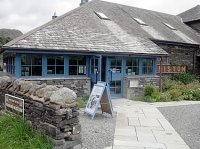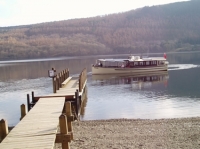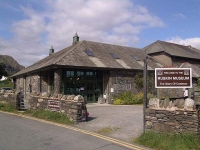![header-ruskin[1] header-ruskin[1]](https://www.cumbriatouristinformation.com/images/sobipro/entries/199/img_header-ruskin[1].png)
 Home
Home
- Submit to Directory
- Directory
- Events
- About Cumbria
- Cumbria Mountains
- Contact Us
- Register/Login
0 Reviews
The Ruskin Museum
Full Description
The Ruskin Museum is an award-winning Cabinet of Curiosities which tells the Story of Coniston. The Rough Guide to the Lake District [all editions] praises ‘Coniston’s superb museum’ as ‘the most thought-provoking in the Lakes’ for its inspirational and award-winning telling of The Story of Coniston from the first Stone Age fell-walkers, who made and traded stone axes, to the Jet Era when the 1950s speed ace Donald Campbell used Coniston Water as Bluebird K7’s race-track. The Ruskin Museum’s Coniston Gallery introduces 500 million year old rocks, and one of the first Rock Bands, who played musical stones; examines the mines that helped to copper-bottom Naval and merchant wooden ships, and the slate quarries that have roofed the world; studies the dry-stone and cobble walls that stride the fells, and looks at the truth to local stone, slate and oak exemplified in traditional vernacular buildings. Coniston is Herdwick country – black lambs, grey sheep with smiling white faces, and an intriguing mix of Celtic and Norse heritage - a hardy native breed whose fleece made John Peel’s ‘coat so grey’. The breed was much-loved by Beatrix Potter, who owned farms in the parish. Coniston is also Swallows and Amazons country. Arthur Ransome fictionalised the lake and The Old Man [The Matterhorn/Kanchenjunga], borrowed Peel Island’s secret harbour for Wild Cat Island, and SY Gondola for Captain Flint’s houseboat, and used the copper-mines and slate-quarries as the context for Pigeon Post. His readers will discover in the museum the sailing dinghy Mavis, the inspiration of the fictional Amazon, complete with centre-board. The Bluebird Wing, has been built as the future home of Donald Campbell’s iconic hydroplane Bluebird K7, once the wreckage from the fatal crash in 1967 has been conserved and rebuilt to operative condition, [see: www.bluebirdproject.com]. This gallery contains extensive displays of memorabilia, a large-screen photographic presentation, touch-screen inter-actives with much background information, the Bristol-Siddeley Orpheus engine that was in the lake for 34 years, and Donald Campbell’s pension plan, the prototype Bluebird JetStar ski-boat. The Ruskin Museum’s Ruskin Gallery holds the most comprehensive display in the Lake District about the life and work of John Ruskin [1819 – 1900], who had one of the most profound and influential minds of the Victorian age, becoming the greatest pundit on aesthetics and ethics in the English-speaking world. He was a superb watercolourist and draughtsman, who worked out most of his ideas visually, through drawing in almost forensic detail – seeing clearly the links between the structure of crystals and the mountains they formed; art and buildings in relation to the society that bred them; the environmental, ecological and moral pollution of the Industrial Revolution and the greed under-pinning Capitalism - and teaching a once blind people how to think and plan for a fairer and more sustainable future. Our Roots & Development The Ruskin Museum was founded as Coniston’s permanent memorial to its most famous resident, John Ruskin, who died on 20 January 1900. Ruskin’s friend, confidant, and first biographer, W.G. Collingwood, organised an influential Ruskin Memorial Exhibition, held in the main Assembly Room in Coniston Mechanics’ Institute over the summer of 1900, and visited by over 10,000 people. The proceeds paid for the construction of a new museum -The Ruskin Museum – dedicated to his memory and celebrating the local cultural and literary heritage. This was opened on 31 August 1901 by Canon H.D.Rawnsley, best known to-day as one of the three founders of The National Trust. Collingwood, fascinated by Ruskin’s method of working out his ideas and theories visually, through drawing, carefully selected watercolours, drawings, sketchbooks, and lecture aids, supplemented by crystals and minerals of geological importance and aesthetic value, and a mix of local curiosities and bygones. The Ruskin Museum is independent. It is owned and managed by the people of Coniston. The advent of the Museums Registration Scheme in the 1980s, [set up to ensure that museums met certain standards of governance, long-term purpose, and collections care], revealed that the Ruskin Museum held one of the most important collections ‘at risk’ in North West England. This galvanised action, spurred on by the establishment of the National Lottery. By the 1990s, The Ruskin Museum was in urgent need of up-dating. Thanks to the Heritage Lottery Fund and European funding, The Ruskin Museum was redeveloped on ‘green’ lines, true to local materials and building styles, and quintupled in size. The cost, including remedial conservation of textiles and works on paper, interpretation and new displays, was some £950,000. It was re-opened in May 1999, to popular and critical acclaim, in good time for the centenary of Ruskin's death on 20 January 2000, and its own centenary on 31 August 2001. The new-look Museum was opened officially on 23 May 2000 by the then Culture Secretary, the Rt. Honourable Chris Smith. On 8 March 2001, the recovery of the wreck of Donald Campbell’s hydroplane Bluebird K7 from Coniston Water led to a further development scheme - the construction of a new extension, The Bluebird Wing, which will house the fully conserved and rebuilt World Water Speed Record-breaker, to celebrate another aspect of Coniston’s unique heritage. This second extension was built in 2008, and is now open, albeit without the central exhibit – but with extensive displays of Campbell and Bluebird memorabilia
The Ruskin Museum
Coniston
LA21 8DU.
LA21 8DU.
Driving Directions
You must login to leave a review
Rating Summary:
0 based on 0 votes
Categories
Galleries and Museums
© 2024 Cumbria Tourist Information



